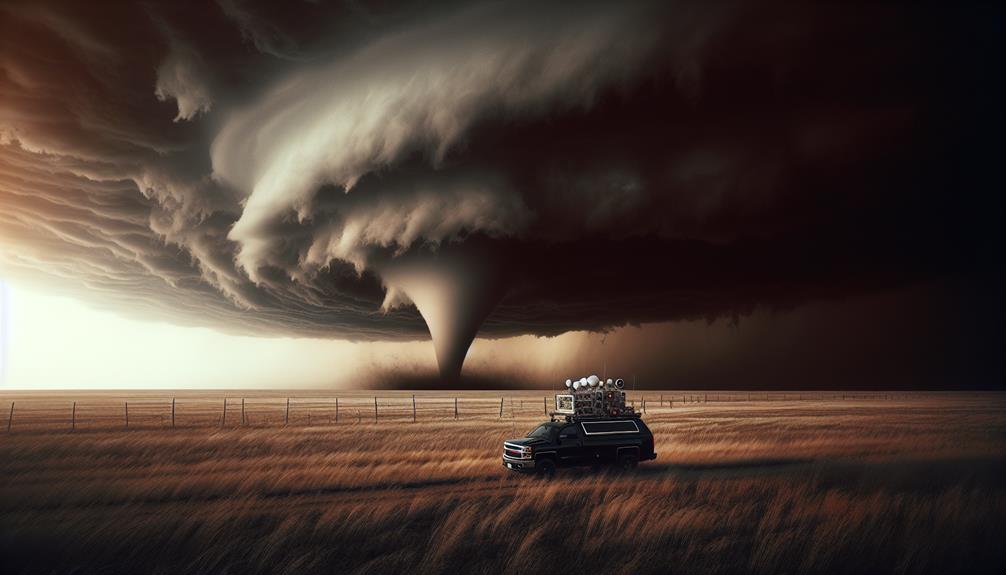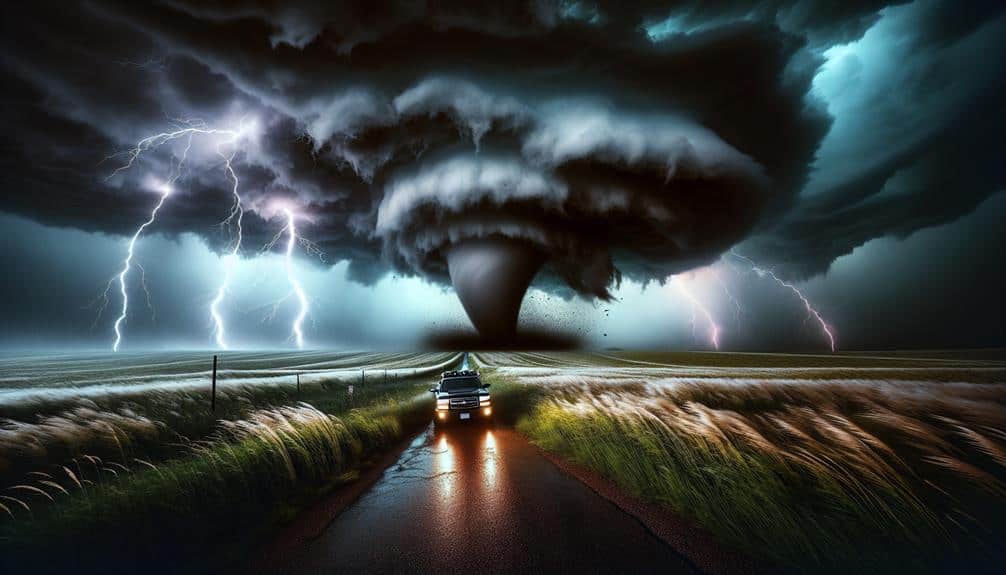Storm chasing, rooted in the 1950s, has significantly advanced meteorological science. We learn from documentaries like 'Tornado Alley' and 'Twister: Fury on the Plains' that techniques such as real-time data collection and instrument calibration are essential. Veteran chasers navigate severe weather with high-resolution tools and rigorous safety protocols. These practices have improved forecasting accuracy, public safety, and scientific understanding of weather phenomena. Documentaries illustrate the importance of teamwork and the detailed methodologies involved. Through these insights, we can appreciate the intricate dynamics at play and understand how they contribute to advancements in storm research and safety.
Key Points
- Documentaries like 'Tornado Alley' demonstrate storm formation and the critical role of chasers in data collection.
- Footage from chaser documentaries highlights techniques for safe and effective storm observation.
- Teamwork dynamics featured in documentaries underscore the importance of communication and safety protocols.
- Real-life chaser stories provide valuable lessons on handling challenges and making real-time decisions.
History of Storm Chasing
The history of storm chasing dates back to the 1950s when meteorologists began systematically tracking severe weather to improve forecasting accuracy. This decade marked the genesis of structured storm observation, driven by a profound need to understand and predict tornadoes. Early pioneers like David Hoadley, who's often considered the father of modern storm chasing, began chasing tornadoes with rudimentary tools, driven by an insatiable curiosity and a mission to gather critical data.
Our journey in storm chasing is rooted in these early efforts. With limited technology, these trailblazers relied on visual cues, basic radar data, and sheer intuition. They meticulously documented weather patterns, providing invaluable insights that would lay the foundation for modern meteorological science. Their work wasn't just about thrill-seeking; it was about advancing our collective knowledge and enhancing public safety.
As storm chasers, we owe much to these early pioneers. Their groundbreaking efforts in chasing tornadoes have enabled significant advancements in forecasting models and emergency response strategies. Their legacy continues to inspire us to push boundaries, harnessing cutting-edge technology to pursue the same goal: understanding and mitigating the impacts of severe weather while embracing the freedom of the chase.
Key Storm Chasing Documentaries
Let's analyze the impact of iconic storm-chasing films and the authentic experiences of real-life chasers.
These documentaries don't just entertain; they offer valuable educational takeaways that enrich our understanding of meteorological phenomena.
We'll assess the data-driven insights they provide and their contributions to both science and public awareness.
Iconic Storm Chasing Films
Iconic storm chasing documentaries provide indispensable insights into meteorological phenomena and the relentless pursuit of understanding severe weather. Through cinematic portrayals, these films bring the thrilling adventures and extreme weather encounters of storm chaser legends to a broader audience.
One standout is 'Tornado Alley,' which offers a data-rich exploration of tornado genesis using IMAX technology. The film captures not only the majestic power of storms but also the scientific rigor behind chasers' quests.
Another seminal work is 'Twister: Fury on the Plains,' a meticulously crafted documentary that integrates real-time data and advanced modeling techniques. By analyzing storm patterns and their impacts, it presents a thorough view of extreme weather phenomena. We also gain insights into the technological advancements in meteorology, such as Doppler radar and storm prediction models.
'Chasing Ice' shifts focus to the broader implications of climate change, documenting the melting of polar ice caps through time-lapse photography. It adds an essential environmental dimension to our understanding of severe weather's global ramifications.
These films not only captivate but also educate, leveraging high-definition visuals and expert commentary to deepen our understanding of storm chasing and its crucial role in meteorological science.
Real-Life Chaser Stories
Real-life chaser stories from key documentaries offer unparalleled insights into the methodologies, challenges, and triumphs experienced by storm chasers in their pursuit to understand severe weather. When we explore these documentaries, the raw chaser experiences stand out—each tornado chase is a calculated dance between risk and reward, fueled by the adrenaline rush of capturing the perfect data and imagery.
We notice that the teamwork dynamics among chasers are crucial. Effective chaser camaraderie ensures safety and operational efficiency. For example, in 'Storm Chasers,' we witness how coordinated communication and role assignment—driver, navigator, meteorologist—optimize data collection while minimizing hazards. These documentaries highlight how the integration of real-time data, GPS tracking, and meteorological expertise form the backbone of successful storm chasing.
Furthermore, the challenges faced—mechanical breakdowns, unpredictable storm paths, and the constant need for situational awareness—are addressed through innovative solutions and adaptive strategies. The triumphs, often captured in breathtaking footage, aren't just visual but scientific, contributing valuable insights into storm behavior.
These real-life stories emphasize the delicate balance between human curiosity and Mother Nature's unpredictability, illustrating the detailed planning and collective effort required to chase storms effectively.
Educational Takeaways Highlighted
Key storm chasing documentaries offer a wealth of educational takeaways, highlighting the sophisticated technologies and analytical strategies that drive successful storm chasing endeavors. By delving into these documentaries, we gain valuable learning opportunities that transcend the experiences of individual storm chasers.
The vivid portrayal of real-time data analysis, Doppler radar utilization, and GPS tracking in these films provides unparalleled educational insights into storm chasing techniques.
Documentaries like 'Tornado Alley' and 'Storm Chasers' meticulously document the methodologies employed by veteran chasers. They illustrate the precision required in data interpretation and the tactical maneuvers executed to stay within safe proximity of a storm. This juxtaposition of documentaries vs. chasers in action underscores the critical balance between theoretical knowledge and practical skill.
Moreover, these films often incorporate interviews with meteorologists and climate scientists, offering a deeper understanding of atmospheric phenomena. The educational insights gained here are instrumental for aspiring chasers. We see how predictive models are developed and applied in real-world scenarios, enhancing our grasp of storm dynamics.
Impact of Storm Chasing on Science

Storm chasing has greatly advanced our scientific understanding of severe weather patterns through direct data collection and real-time observation. By immersing ourselves in the midst of storms, we've made significant scientific advancements that traditional methods alone couldn't achieve. Our research provides critical data that enhances meteorological knowledge, helping us refine forecasting models.
Through storm chasing, we've gathered high-resolution measurements of wind speeds, pressure drops, and temperature variations. This data is invaluable for creating more accurate simulations of storm dynamics. By using mobile Doppler radar and deploying ground-based sensors, we've captured data that helps improve predictive algorithms. As a result, our forecasts aren't only more precise but also more timely, giving communities better preparation time.
Moreover, our hands-on approach allows us to observe phenomena that are otherwise difficult to study. For example, the formation of tornadoes and microbursts can be observed in real-time, providing insights that static instruments can't offer. This real-time observation leads to quicker scientific breakthroughs and more robust meteorological knowledge.
Ultimately, storm chasing is more than just a thrilling endeavor; it's a cornerstone of modern weather research that directly contributes to public safety and scientific progress.
Techniques Used by Storm Chasers
While our research has greatly benefited from storm chasing, the techniques we employ are essential to the success of our data collection and analysis. Our first step involves meticulous equipment preparation. We calibrate instruments like anemometers, barometers, and Doppler radars to guarantee accurate measurements. High-resolution cameras and GPS devices are also crucial for tracking storm progression.
For observation techniques, we position ourselves strategically to capture the storm's development without interfering with its natural course. This involves real-time analysis of meteorological data and adjusting our location based on storm patterns. Precise observation enables us to collect vital data on wind speeds, pressure changes, and other meteorological variables.
Data collection is systematic and continuous. We employ automated weather stations to log data at regular intervals, ensuring no essential information is missed. Mobile data collection units allow us to gather information even while on the move, providing a thorough dataset.
Effective communication strategies are crucial. We use satellite phones and dedicated radio frequencies to maintain constant contact with our team members and research base. This ensures data is relayed promptly and any adjustments needed for observation or data collection are communicated swiftly. This robust approach maximizes our research efficiency and accuracy.
Safety Measures for Storm Chasers

Safeguarding our safety during storm chasing demands rigorous protocols and constant vigilance. Equipment preparation is paramount. We meticulously inspect our vehicles, confirming they're equipped with essential tools like GPS, weather radar, and first-aid kits. Each piece of gear is calibrated and tested to handle extreme conditions. Safe practices dictate that we wear appropriate clothing, including helmets and sturdy boots, to shield against debris and high winds.
Communication protocols are equally critical. We establish clear lines of communication within our team, utilizing two-way radios and satellite phones to maintain constant contact. This guarantees that everyone is aware of their roles and any changes in the storm's trajectory. Regular check-ins with local weather stations provide real-time updates, enhancing our situational awareness.
Emergency procedures are ingrained into our routine. We've predefined escape routes and rendezvous points. Every team member is trained in CPR and emergency medical response. We also carry emergency supplies, such as water, non-perishable food, and blankets, to prepare for any unforeseen circumstances.
Educational Benefits of Storm Chasing
Engaging in storm chasing provides unmatched hands-on learning experiences that deepen our understanding of meteorological phenomena. By directly observing weather patterns, we gain insights that are often overlooked in traditional classroom settings. The adrenaline rush of being in the field sharpens our focus and heightens our observational skills, enabling us to collect real-time data that greatly enhances our ability to forecast severe weather.
In the field of meteorological education, storm chasing offers a dynamic platform to develop and refine our forecasting skills. We learn to interpret radar imagery, analyze atmospheric conditions, and predict storm development with greater precision. This hands-on approach accelerates our understanding of complex weather systems, fostering a more thorough and practical comprehension.
Data-driven analysis from storm chasing expeditions provides invaluable contributions to meteorological research. By systematically documenting our findings, we help bridge gaps in existing weather models and improve prediction algorithms. The real-world challenges we encounter necessitate rapid problem-solving and adaptability, crucial skills that are transferable to various scientific and investigative fields.
Ultimately, the freedom to explore and engage with nature's most powerful forces empowers us to push the boundaries of our knowledge. Our collective experiences in storm chasing not only enhance our scientific expertise but also inspire a deeper appreciation for the intricate dynamics of our atmosphere.
Frequently Asked Questions
What Qualifications Do You Need to Become a Storm Chaser?
To become storm chasers, we need meteorology expertise and field experience. Advanced degrees in atmospheric sciences and practical training greatly enhance our skills. This combination empowers us to analyze weather patterns and safely navigate severe storms.
How Do Storm Chasers Fund Their Expeditions?
Picture us driving through a tornado's fury, cameras rolling. We fund our expeditions through a mix of funding sources: personal savings, crowdfunding, and sponsorship opportunities from media outlets, research institutions, and weather-related companies.
What Personal Gear Is Essential for a Storm Chaser?
For storm chasers, essential personal gear includes safety precautions equipment like helmets and first aid kits, along with communication and navigation tools such as GPS, radios, and smartphones. This guarantees we're prepared and can stay connected.
Are There Any Famous Storm Chasers Who Are Also Scientists?
When we think about reputable scientists who are also adventurous chasers, Dr. Josh Wurman and Dr. Reed Timmer come to mind. They've combined rigorous scientific methods with the thrill of storm chasing, enriching our understanding of severe weather.
How Do Storm Chasers Handle Emergency Situations During a Chase?
During emergency situations, we follow strict emergency protocols to guarantee safety. While the adrenaline rush can be intense, our focus remains on data-driven decisions, maintaining analytical clarity to navigate and respond effectively to any danger.


